Introduction
social media manager, your job is to create and manage engaging content that drives traffic to your brand’s social media accounts.
To ensure that your content is consistent and effective, you need to stay organized and follow a structured routine.
By creating a daily, weekly, and monthly checklist, you can streamline your workload and achieve your social media goals.
In this blog post, we will cover the social media manager’s daily, weekly, and monthly checklist.
The importance of a social media manager’s checklist

A social media manager’s checklist is a crucial tool for effective social media management.
It helps the manager stay organized and on track with daily, weekly, and monthly tasks, ensuring that all necessary steps are taken to maintain and improve social media accounts.
The checklist also helps the manager maintain consistency in content creation and engagement with the audience.
By using a checklist, the manager can save time, avoid missing important tasks, and maintain a cohesive social media strategy.
Additionally, it provides a valuable resource for tracking progress and evaluating performance over time.
Overall, a social media manager’s checklist is essential for success in the fast-paced world of social media management.
Explore the social media manager’s daily, weekly, and monthly checklist
Daily Checklist:
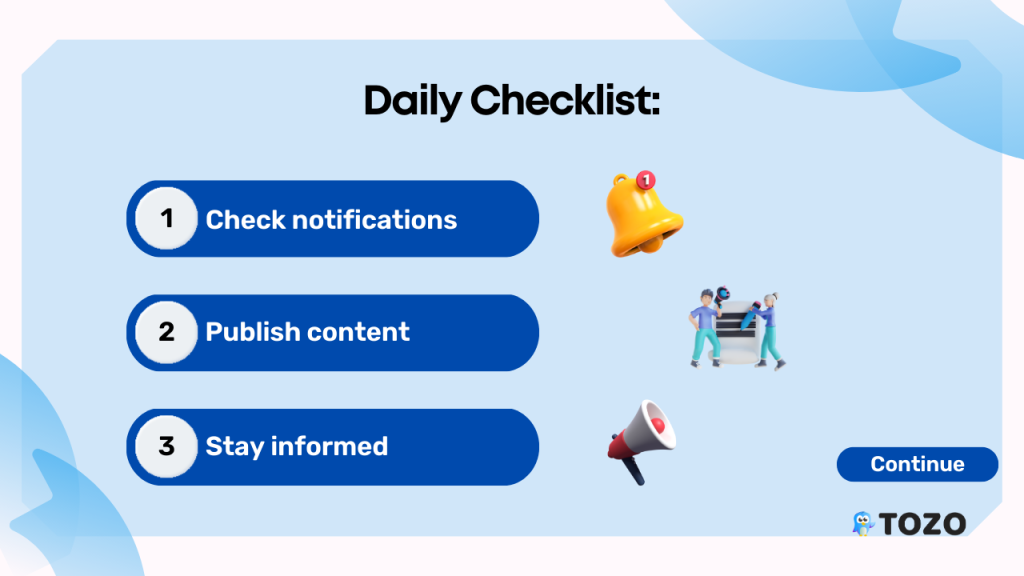
1. Check notifications:
Responding to comments and messages promptly is crucial for maintaining a positive relationship with your audience.
Whether it’s thanking someone for their positive feedback or addressing a customer’s issue, responding quickly shows that you value their input and are dedicated to providing quality customer service.
2. Publish content:
When creating and publishing content, it’s important to consider each platform’s unique features and audience preferences.
For example, Instagram is a highly visual platform, so using high-quality images and videos is essential, while Twitter is more text-based and requires concise messaging.
Schedule tool and publish daily posts across all social media platforms, adhering to the content calendar.
Create engaging and visually appealing content that aligns with your brand’s tone and values.
3. Stay informed:
Staying informed about industry-related news and sharing it on your social media accounts can position your brand as a thought leader in your industry.
This can help increase your brand’s visibility and build trust with your audience.
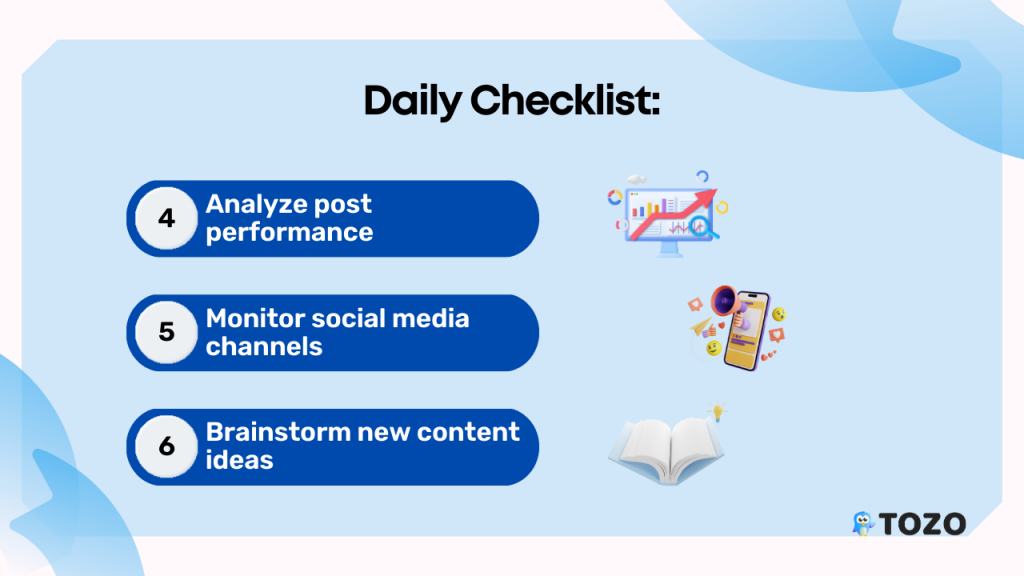
4. Analyze post performance:
Using a social media management tool like Tozo.social, analyze the performance of your posts from the previous day.
This might assist you in determining the kinds of material that are connecting with your audience so that you can modify your plan accordingly.
5. Monitor social media channels:
In addition to publishing content, it’s important to actively monitor your social media channels for any mentions, comments, or messages.
Responding to followers in a timely manner can help build engagement and trust with your audience.
6. Brainstorm new content ideas:
One of the most important tasks for a social media manager is to constantly come up with new content ideas.
Creating high-quality, engaging content on a consistent basis is crucial for building your brand’s reputation, growing your audience, and driving traffic to your website.
Set aside time each day to brainstorm new content ideas for your social media channels. This can help you stay creative and keep your content fresh and engaging.
Weekly Checklist:
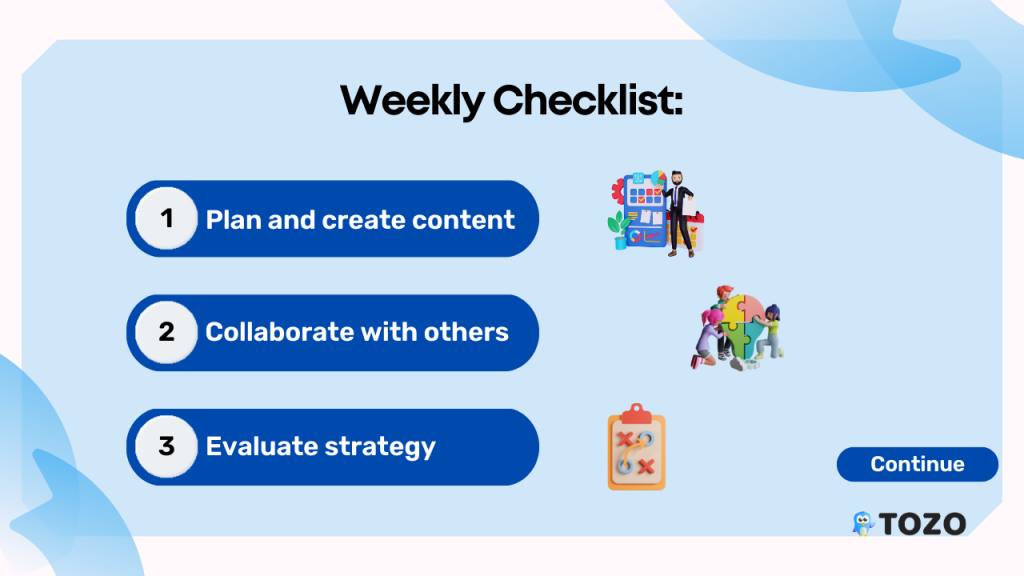
1. Plan and create content:
Planning and creating content in advance can help you stay organized and ensure that your social media accounts are consistently updated with fresh content.
Use a content calendar to plan your posts in advance, and consider creating a mix of content types such as blog posts, videos, and graphics.
2. Collaborate with others:
Partnering with other brands, influencers, and brand advocates can help you reach new audiences and build relationships within your industry.
Consider hosting a collaborative campaign or featuring other brands’ content on your social media accounts to expand your reach.
3. Evaluate strategy:
Evaluating the effectiveness of your social media strategy is important for identifying areas for improvement.
Look at metrics such as follower growth, engagement, and reach to determine what’s working and what isn’t, and make adjustments accordingly.
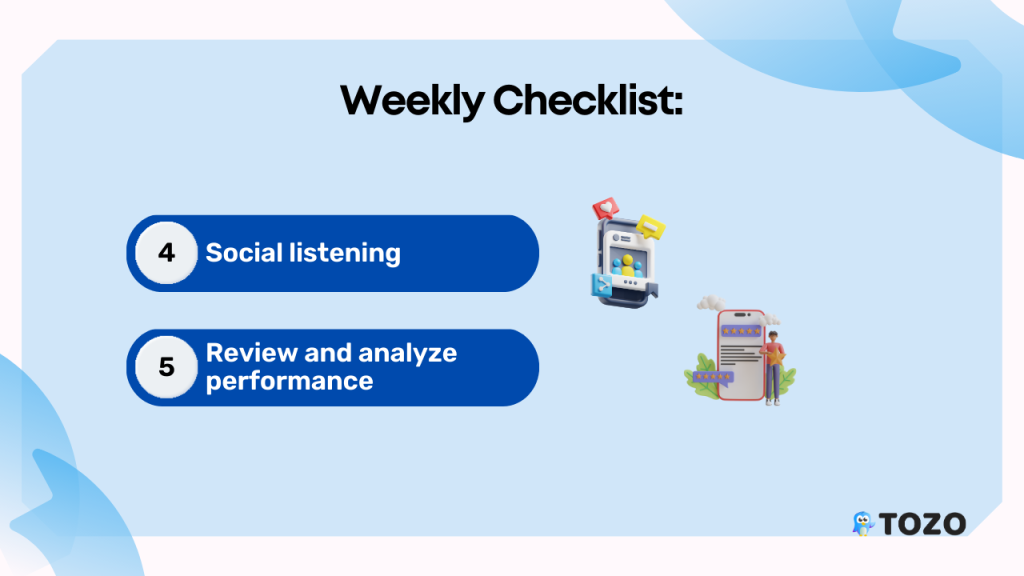
4. Social listening:
Social media listening involves monitoring conversations around your brand and industry and using that feedback to improve your strategy.
Use social media listening tools to track mentions of your brand and industry keywords, and use that feedback to improve your content and customer service.
5. Review and analyze performance:
Take time each week to review and analyze the performance of your social media channels.
Look at metrics like engagement, reach, and impressions to see how your content is performing and identify areas for improvement.
Monthly Checklist:
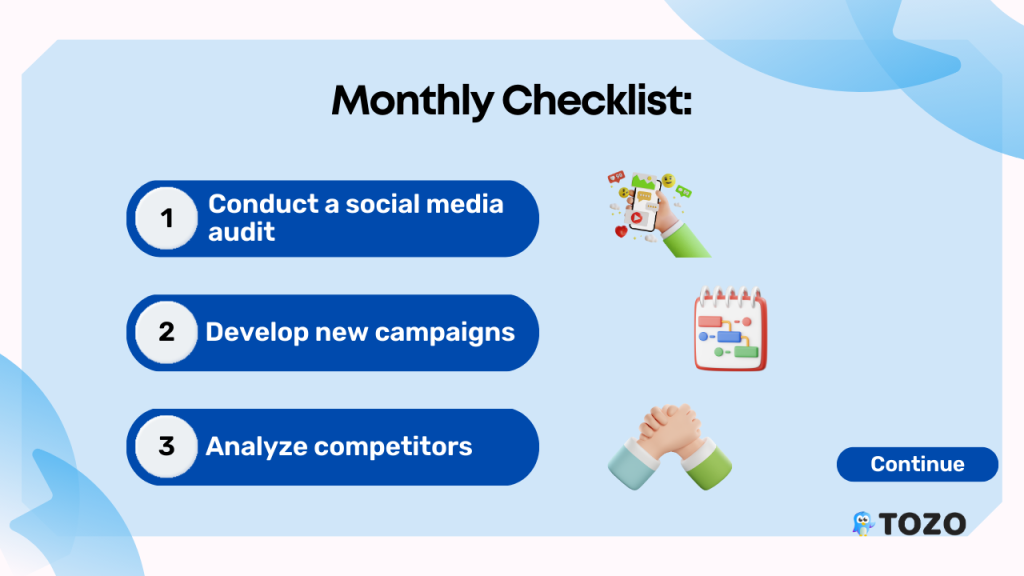
1. Conduct a social media audit:
A social media audit involves evaluating the effectiveness of your current strategy and identifying areas for improvement.
Look at metrics such as engagement, reach, and follower growth, as well as qualitative feedback from your audience, to determine what’s working and what isn’t.
2. Develop new campaigns:
Developing new social media campaigns or initiatives can help you attract new followers and increase engagement.
Consider hosting a giveaway or launching a new product or service, and promote it heavily on your social media accounts to generate buzz.
3. Analyze competitors:
Analyzing your competitors’ social media strategy can help you identify new opportunities and stay ahead of the curve.
Look at their content strategy, messaging, and engagement rates to determine what’s working well for them and how you can incorporate those tactics into your own strategy.
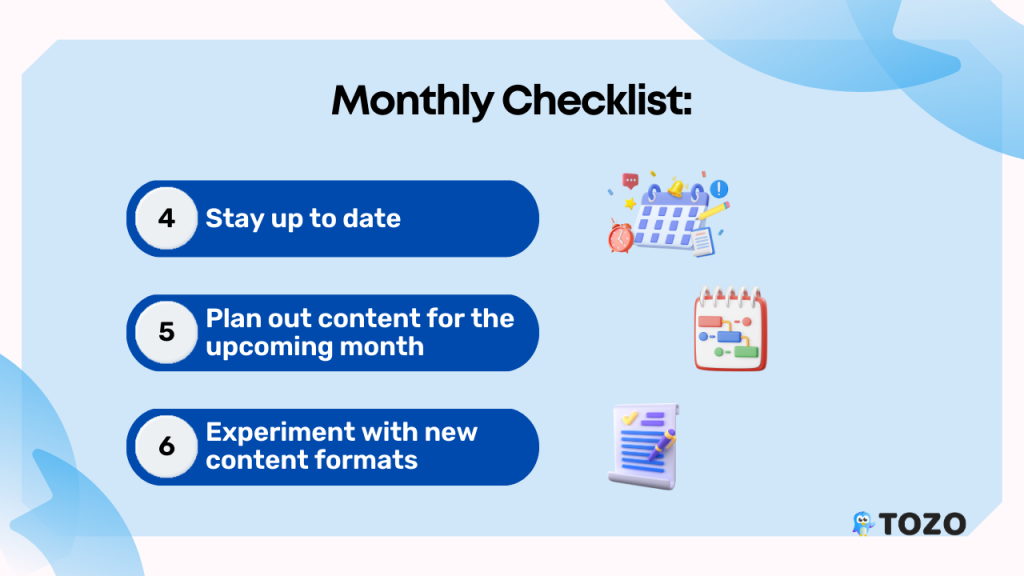
4. Stay up to date:
Social media platforms are constantly evolving, so staying up to date on the latest trends and changes is essential for maintaining an effective social media strategy.
Subscribe to industry publications and follow thought leaders in your industry to stay informed and adjust your strategy accordingly.
5. Plan out content for the upcoming month:
Planning out your social media content in advance is an important part of ensuring that you’re consistently creating high-quality content that resonates with your audience.
By taking the time to plan out your content in advance, you can ensure that you’re covering all the important topics and events that are relevant to your audience, and that you’re not missing any key opportunities to engage with them.
6. Experiment with new content formats:
Consider experimenting with new content formats like video, live streaming, or user-generated content.
This can help you keep your content fresh and engaging, and may help you reach new audiences.
Conclusion
The Social Media Manager’s Daily, Weekly, Monthly Checklist is a comprehensive guide that helps you stay organized and manage your social media accounts effectively.
By following these checklists and utilizing tools like Tozo.social, you can save time, produce higher quality content, and engage with your audience in a meaningful way.
Managing social media can be overwhelming, but with a solid checklist in place, you can streamline the process and achieve your social media goals with ease.



